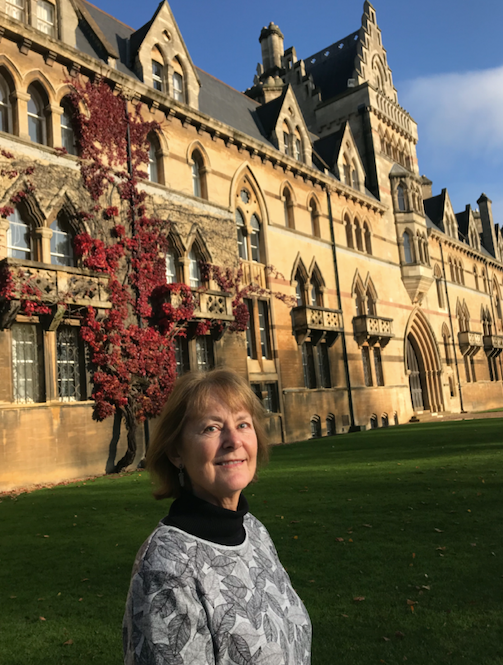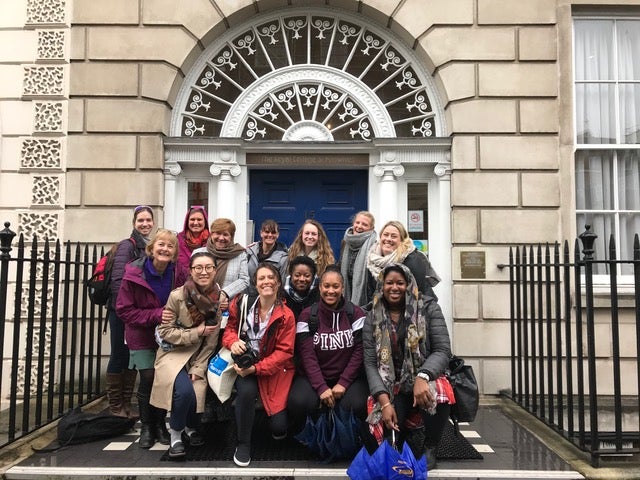Georgetown Nurse-Midwifery Professor Enjoys Semester as Faculty Resident at Oxford
November 12, 2019 – Dr. Cindy Farley, an associate professor in the Nurse-Midwifery/Women’s Health Nurse Practitioner Program, says she is sad for her semester as a Georgetown faculty resident at the University of Oxford to come to an end.

“I am already grieving my leaving,” she admits. Farley has been in England this fall through the Campion Hall Residency Program, which is sponsored by Georgetown’s Office of the President and coordinated by the Office of the Vice President for Global Engagement. Campion Hall is the Jesuit hall of the University of Oxford.
“I am very grateful for this Campion Hall faculty residency experience,” she says. “I am heartened to see that compassionate, caring midwives are striving and thriving across the globe to help women achieve safe and satisfying birth.”
Fostering Learning Abroad
Farley directed her time in the residency program to create a short-term study abroad opportunity for her graduate students, one that would be open to nurse-midwifery/WHNP students who were in the Georgetown program’s last semester. “Each traveling student chose an aspect of midwifery care to compare United Kingdom to United States practices,” she says.
Earlier this semester, for a week, 10 Georgetown students from the online program and three faculty, including Farley, had an “exhilarating and exhausting” time, including seeing the set of the popular series “Call the Midwife.”
Other signature activities involved visiting the Royal College of Midwives and touring multiple free-standing birth centers, hospital obstetric units, and midwife-led units. Students had the chance to collaborate with peers in the UK and socialize at a pub one evening. Additionally, the Rev. Nicholas Austin, SJ, master of Campion Hall, discussed Jesuit values with the students.
Differences in Midwifery Care

Farley notes a number of differences in midwifery care between the United States and the United Kingdom.
“Midwives attend 90 percent of the vaginal births in the UK compared to the 10 percent of vaginal births that midwives attend in the US,” she says. “Birth in the UK is supported as a normal, physiologic process in ways that maintain the active participation of the woman and her family. Ambulation, hydrotherapy in labor, and water birth are used frequently. Women have choice of birth place, including home birth.”
She also highlights a “much lower maternal and infant morbidity and mortality rates, and much of this is due to the influence of midwifery care,” as well as differences in the health care system. “Pregnant women simply book their prenatal care appointments, and this care is covered,” she says.
That said, she adds, “they do struggle with similar issues to the US, [including] over-medicalization of birth, meeting needs of diverse populations, and lifestyle choices that undermine health, such as poor eating habits and smoking.”
A Memorable Time
As her time at Oxford comes to a close, Farley says she is “investigating the possibilities for on-going exchanges and research opportunities with British midwives.”
She happily shares about the enjoyable Georgetown “flat” at Campion and its location “just across from the iconic Christ Church College of Oxford University.”
“My favorite walk is around Christ Church Meadow, bordered by the college and the confluence of the rivers Cherwell and Thames,” she says. “There are oxen grazing in this meadow, a reminder of how the city was named.”
The setting causes a sense of connection to the past for her.
“In some areas of the city, you can imagine yourself back in medieval times as you walk on cobblestone streets in the midst of stunning architecture,” she says.
